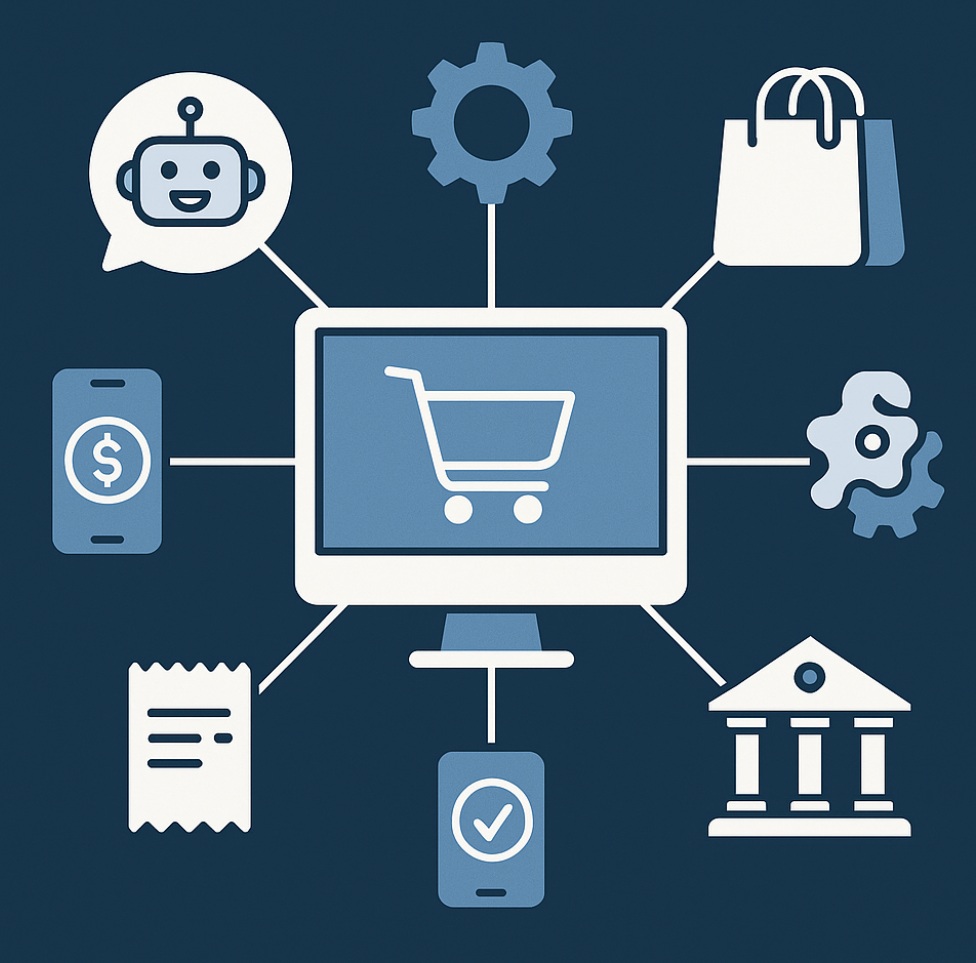Remember when people hesitated to enter their credit card details online?
Now they casually order dinner through an app that connects their wallet to a stranger’s kitchen and a courier they’ll never meet. That trust didn’t appear overnight; it evolved through systems that were predictable, auditable, and safe – principles central to how CROZ helps enterprises build trustworthy AI systems.
The next evolution is already here: agentic commerce – AI agents that can make purchases on behalf of users under strict, verifiable authorization. This new era blends automation, trust, and personalization to create an entirely different way of engaging with the digital economy.
How the Big Players Are Shaping Agentic Commerce
OpenAI and Stripe: Agentic Commerce Protocol
OpenAI, working with Stripe, is positioning ChatGPT as a superapp for everything – from finding the perfect bag for a weekend trip to booking flights or managing subscriptions. Through the Agentic Commerce Protocol, ChatGPT collects user consent, issues secure payment tokens, and connects with merchants via their existing systems. Merchants remain the merchant of record, ensuring compliance and control.
Because the specification is open source, any business or AI agent can implement it, making agentic commerce interoperable and accessible to a wide ecosystem.
Google: Agent Payments Protocol (AP2)
Google’s approach to agentic commerce revolves around a broader open protocol: the Agent Payments Protocol (AP2) – that any agent can implement, regardless of platform or developer. Here, users create digitally signed Mandates that define exactly what an agent can buy, when, and for how much.
These Mandates are cryptographically tamper-proof and travel with the transaction, providing verifiable proof of user authorization. AP2 supports cards, bank transfers, and even crypto, allowing agentic commerce to operate seamlessly across payment rails.
Microsoft and Perplexity: Expanding Agentic Networks
Perplexity has integrated PayPal checkout for shopping and travel bookings, while Microsoft’s Copilot Merchant Program lets brands sell directly within Copilot. Each of these moves expands the agent-led ecosystem, making agentic commerce a mainstream commercial channel rather than a futuristic experiment.
Why Trust Is the Foundation of Agentic Commerce
Think about your behavior on a food delivery app. You trust it because:
– You explicitly approve each order.
– The price is locked before payment.
– You get receipts, tracking, and refunds under clear rules.
Agentic commerce works in much the same way – just at a broader scope. The agent acts as a trusted proxy, executing your intent within predefined parameters. You still control permissions, the merchant fulfills the order, and there’s an auditable trail that keeps every party accountable.
At its core, agentic commerce depends on four pillars of trust:
- Explicit consent – users define exactly what an agent can do.
- Tamper-proof authorizations – signed digital Mandates verify every action.
- Auditability – transactions remain transparent and traceable.
- Merchant control – sellers stay the merchant of record, maintaining compliance and liability.
What Agentic Commerce Looks Like in Practice
The real magic of agentic commerce is in the new shopping behaviors it enables – interactions that weren’t possible before. These fall into two main categories:

1. Human-Present Mode: The Agent as Research Assistant
Imagine your customer asking their AI agent to compare car insurance policies. The agent:
- Gathers quotes from multiple providers,
- Negotiates for the best rate,
- Highlights differences in coverage and perks,
- Presents the results in plain language.
The customer reviews and selects the best fit – completing enrollment right inside the chat. The agent performs the legwork; the human still makes the decision.
This semi-autonomous workflow illustrates trust through transparency; a defining trait of agentic commerce.
2. Human-Not-Present Mode: Delegated Execution
Now imagine the customer gives a more autonomous instruction:
“Monitor secondary market tickets for AC Milan vs Inter, buy two seats if the price drops below €100 each.”
They sign an Intent Mandate defining price, timing, and quantity.
The agent monitors multiple resale platforms, and once conditions are met, it automatically executes a Cart Mandate – finalizing the purchase within approved rules.
Or take inventory management: a procurement officer instructs,
“Reorder supplies when stock drops below 20 units, from our approved vendor, at standard contract price.”
The agent monitors stock levels and reorders automatically – no human in the loop.
These delegated flows only work because of verifiable, cryptographic proof structures. Merchants can see exactly what the user authorized, when, and for how much.
The Stablecoin Dimension
Agentic commerce isn’t just about automation – it’s about payments that can keep up with it. Stripe is developing infrastructure so agents can transact using stablecoins, providing:
- Instant settlement,
- 24/7 uptime (no banking hours),
- Borderless transactions,
- Optional auto-conversion to fiat.
Merchants can choose to instantly convert stablecoins into their preferred currency or retain them for direct spending. For banks and financial institutions, this redefines what a “payment” even means – when the payer could be an autonomous agent executing blockchain-based settlements.
Building Trust in Agentic Systems
For agentic commerce to scale, trust frameworks must mimic what users already expect:
- Explicit consent flows (like “approve this purchase”).
- Predictable pricing and refunds.
- Digital receipts and tracking.
- Verifiable authorization logs.
This continuity of trust – from the earliest web transactions to agent-driven autonomy, is what makes the system adoptable.
Opportunities and Questions for Businesses
Each wave of digital commerce rewarded early adopters. From storefronts to desktop, to mobile, to conversational commerce – and now agentic commerce – those who adapt early gain disproportionate advantages.
But the opportunity brings new strategic questions:
- How will merchants ensure their products are surfaced correctly when agents, not humans, do the shopping?
- What defines fair comparison when AI negotiates on behalf of users?
- How will fraud detection evolve when the “buyer” might be an autonomous script?
- What happens to loyalty programs when agents optimize purely for price and convenience
These aren’t distant hypotheticals – they’re the new strategic playbook.
The Path Forward: Adapting to Agentic Commerce
The infrastructure for agentic commerce is already being standardized by major players. But to thrive in this new landscape, businesses must adapt by:
- Integrating with open protocols like OpenAI’s Agentic Commerce Protocol or Google’s Agent Payments Protocol.
- Designing agent-friendly APIs that expose clear metadata, inventory, and pricing.
- Implementing transparent audit trails to track agent actions and customer authorizations.
- Developing agent governance policies – defining what AI agents can and cannot do within your systems.
- Experimenting early – starting with human-present assistance before full automation.
The Future of Agentic Commerce
Agentic commerce represents a fundamental change in how value flows online. We’re moving toward an era of AI-mediated consumption, where agents interact with agents, compare offers, and transact in real time on behalf of humans.
Future trends point toward:
- Multi-agent ecosystems and specialized shopping agents.
- Transparent, open marketplaces for agent-to-agent commerce.
- Seamless integration of stablecoin and fiat rails.
- Greater personalization and predictive buying.
In short: commerce that works while you sleep – but stays under your control.
Conclusion: The Next Leap in Digital Trust
The rails are here. The protocols are being tested. What remains is execution.
Agentic commerce will redefine buying as an act of intent rather than interaction. The businesses that embrace it early will lead the next wave of digital trust – just as those who embraced online payments did two decades ago.
The question isn’t if this transformation arrives. It’s whether you’ll be ready when your customers’ agents start shopping for them.



